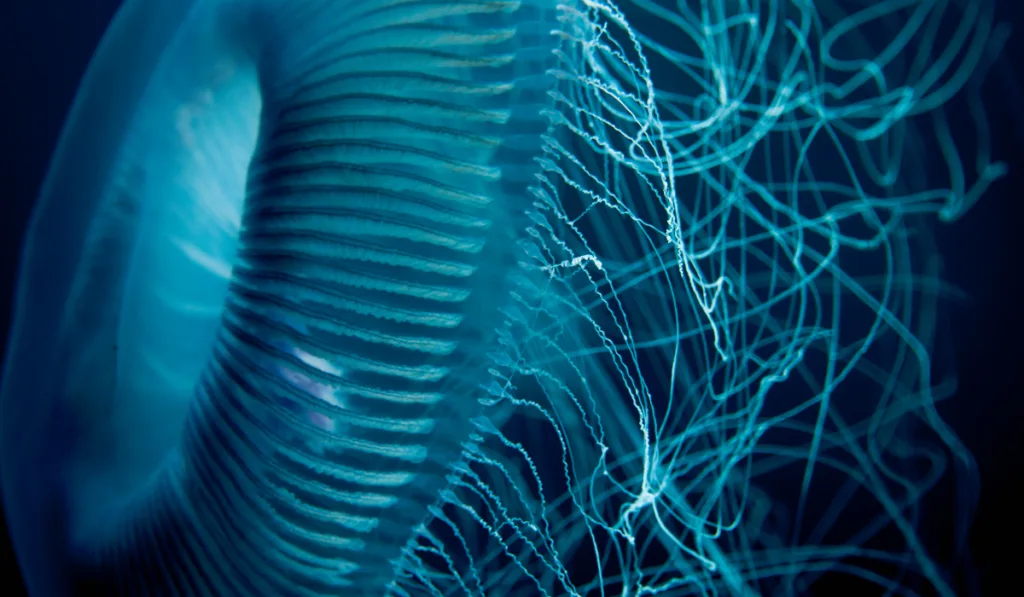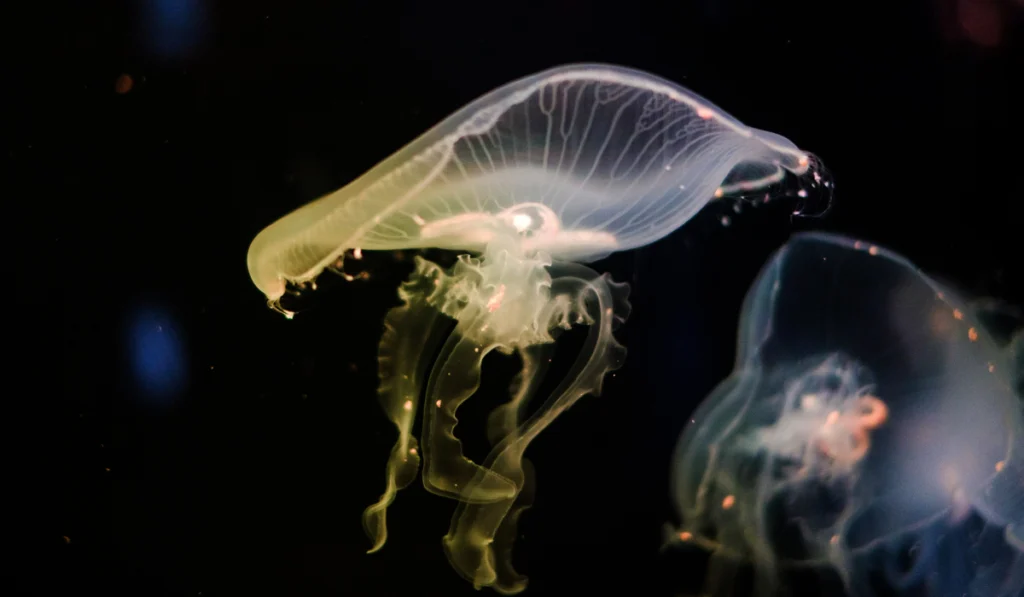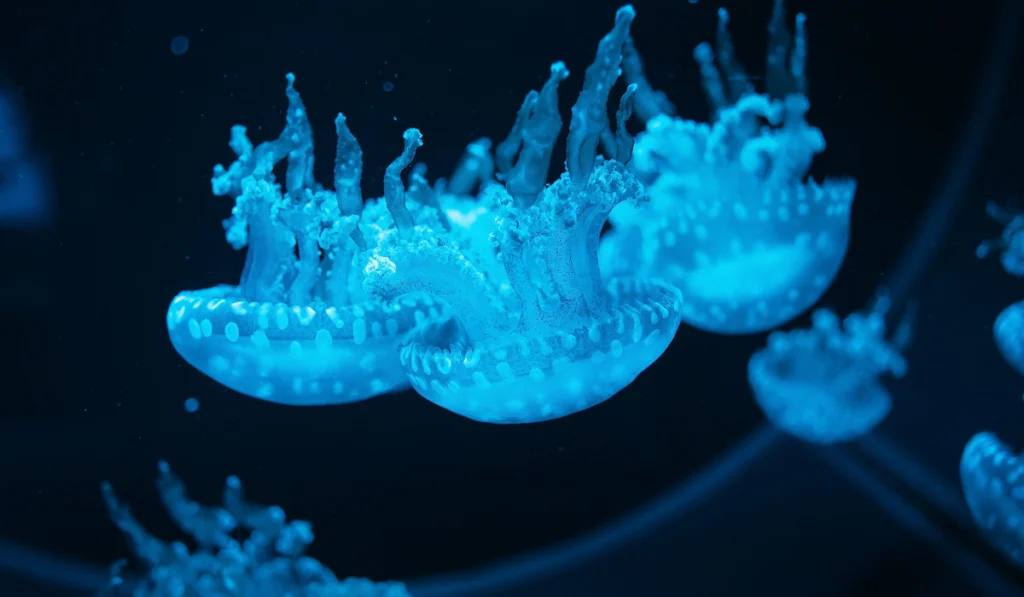Jellyfish are aquatic invertebrate animals that do not have a backbone. They are members of the phylum Cnidaria family and known for their bell-shaped and gelatinous bodies.
Jellyfish are renowned for their stinging and paralyzing tentacles that they use for defense and for capturing their food. But jellyfish look very unlike most other marine animals, so how do they eat once they do find their food?
Do jellyfish have mouths?
The mouth of the jellyfish is located at the center of its body. It is through this singular opening that they both feed and discard waste. Jellyfish also use their mouths to propel themselves forward with movement by squirting out a jet of water.

A jellyfish mouth may not look like most mouths on other marine life such as fish. But they have some unique abilities that help them survive.
Table of Contents
Do Jellyfish Have Mouths?
Jellyfish have an opening or an orifice which functions as both a mouth and an anus. The orifice is usually found underneath the bell-shaped body of the jellyfish.
Jellyfish have long and numerous tentacles. Amidst their tentacles, you’ll find some parts called oral arms. Oral arms help move captured food to the mouth of the jellyfish.
Some species of jellyfish have evolved to the extent of eliminating the need for a physical mouth. These jellyfish absorb their food directly through the openings in their oral arms.

How Do Jellyfish Eat Their Food?
Jellyfish are limited by the size of food they can fit into their mouths. It will be unable to consume food that is not small enough to pass through its mouth.
After using its tentacles to paralyze, stun, or kill their prey, the jellyfish pulls the food into its mouth by using its oral arms
Jellyfish don’t have any teeth or a means to chew their food. The food goes straight to the gastrovascular cavity which acts like its stomach. This cavity has a special lining that allows the jellyfish to break down food into necessary nutrients.
Once the jellyfish absorbs the usable food, the food waste exits its body through the same mouth opening.
With jellyfish being mostly translucent, you can see it digesting food. Digestion in jellyfish is a relatively quick process to ensure they can keep moving.
How Do Jellyfish Get Their Food?
Jellyfish have naturally long tentacles for capturing food. In some species, these tentacles can grow up to 100 feet in length.

Each tentacle is covered with a numerous amount of cells called cnidoblasts. These cells contain nematocysts which, in turn, contain stinging threads.
When a jellyfish captures a small fish with its tentacles, the threads uncoil from the pressure release inside the nematocyst. The stinging cells are then flung out like tiny darts toward the prey. These cells then inject the prey with venom.
The venom of a jellyfish has a neurotoxin that paralyzes the prey. The amount of venom used to catch prey depends on the size of the food.
What Do Jellyfish Eat?
Jellyfish are carnivorous and will eat any living thing that is small enough to fit through their mouths.
They are regarded as opportunistic predators because they will eat anything they can find or that comes to them rather than ambush or pursue their prey.
Jellyfish in the wild eat a variety of zooplankton, which are tiny sea animals. Depending on the jellyfish species and size, they will eat anything from fish eggs and larvae to small fish and crustaceans.
In some cases, adult jellyfish can become cannibals and feed on other jellyfish.
When kept as pets, the recommended food for jellyfish is brine shrimp. You can purchase brine shrimp at any aquatic pet store. You may also buy brine shrimp as eggs that you can hatch yourself or grown adults.
9 Animals Jellyfish Love to Eat
- Brine shrimp
- Krill
- Crabs
- Lobsters
- Fish egg larvae
- Sea slugs
- Small fish
- Sea snails
- Other jellyfish
How Much Do Jellyfish Eat in a Day?
Jellyfish are opportunistic eaters. In the wild, jellyfish will eat as much as they can as long as it is available. The amount of food available to them tends to vary daily as a result of ocean currents.

If you keep jellyfish as pets, you should feed them at least once a day. Their feeding rate will depend on the species, size, and number of jellyfish you keep.
It is important to provide live food for your jellyfish regularly. Live food is less likely to ruin the quality of the water.
Does a Jellyfish Poop?
Jellyfish do not poop, but they do excrete waste. Jellyfish do not release waste the same way that other animals do because they lack a developed digestive system and specialized anus.
Once digestion in a jellyfish is complete, the undigested food goes out the same way it came in: through the mouth opening at the center of its body.
Water flowing through the jellyfish body cleans out pieces of food that are not needed, acting like an excretory system.
The process of removing unwanted food from jellyfish ensures that there is space for incoming food.
In jellyfish, water also acts as a circulatory system. It moves oxygen and food around the jellyfish body and provides it with what it requires to live.
Final Thoughts
Some jellyfish species have mouth openings that also act as an exit point for waste products.
Other species have openings in their oral arms that can be used as mouths.
Jellyfish tend to eat anything, provided it passes through their mouths and can be digested quickly so they can remain afloat.
Resources
- https://interestingengineering.com/7-animals-to-identify-by-their-characteristic-poop
- https://jellybiologist.com/2018/05/22/jellyfish-dont-throw-up-or-poop-they-throop-they-throop-through-their-manus/
- http://contemplatingnature.blogspot.com/2010/09/jellyfish-vixens-of-sea.html
- https://animalinfoworld.com/what-do-jellyfish-eat/
- https://www.bioexpedition.com/jellyfish-feeding/
- https://www.amnh.org/explore/news-blogs/news-posts/anatomy-of-a-jellyfish
- https://animalhow.com/how-do-jellyfish-eat-and-what-do-they-eat/
